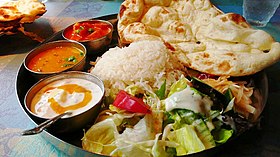Northern
North Indian cuisine is distinguished by the proportionally high use of dairy products; milk, paneer, ghee (clarified butter), and yoghurt (yogurt, yoghourt) are all common ingredients. Gravies are typically dairy-based. Other common ingredients include chilies, saffron, and nuts.
North Indian cooking features the use of the "tawa" (griddle) for baking flat breads like roti and paratha, and "tandoor" (a large and cylindrical coal-fired oven) for baking breads such as naan, and kulcha; main courses like tandoori chicken also cook in the tandoor. Other breads like puri and bhatoora, which are deep fried in oil, are also common. Goat and lamb meats are favored ingredients of many northern Indian recipes.
The samosa is a popular North Indian snack, and now commonly found in other parts of India, Central Asia and the Middle East. A common variety is filled with boiled, fried, or mashed potato. Other fillings include minced meat, cheese (paneer), mushroom (khumbi), and chick pea.
The staple food of most of North India is a variety of lentils, vegetables, and roti (wheat based bread). The varieties used and the method of preparation can vary from place to place. Popular dishes include buknu, gujiya, chaat, daal ki kachauri, mirchi bada, jalebi, imarti, several types of pickles (or achar), murabba, sharbat, pana and aam papad. Popular sweets include mithai, such as gulab jamun, peda, khurchan, petha, rewdi, gajak, milk cake, balushahi, bal mithai, singori, kulfi, falooda, khaja, ras malai, gulqand, and several varieties of laddu, barfi and halwa.
Some common North Indian foods such as the various kebabs and most of the meat dishes originated with Muslims’ incursions into the country. Pakistan was part of North India prior to the partition of India. As a result, Pakistani cuisine is very similar to northern Indian cuisine.
Eastern
East Indian cuisine is famous for its desserts, especially sweets such as rasagolla, chumchum, sandesh, rasabali, chhena poda, chhena gaja, and kheeri. Many of the sweet dishes now popular in Northern India initially originated in the Bengal and Orissa regions. Apart from sweets, East India cuisine offers delights of posta (poppy seeds).
Traditional Bengali cuisine is not too spicy, not too faint. General ingredients used in bengali curries are mustard seeds, cumin seeds, black cumin, green chillies,cumin paste, mustard paste, curd, nuts, poppy seed paste, cashew paste,etc. and cooked in mustard oil.Curries are classified into bata(paste), bhaja(fries), chochchoree(less spicy vapourized curries) and jhol(thin spicy curries).These are eaten with plain boiled rice or ghonto(spiced rice). Traditional Bengali breakfast includes pantabhat(biotically degenerated boiled rice), doi-chirey, doodh-muree with fruits,etc. Bangladeshi cuisine is very similar to East Indian cuisine. Fish and seafood are very popular in the coastal states of Orissa and West Bengal.
Like South India, rice is the staple grain in Eastern India. A regular meal consists of many side dishes made of vegetables. The popular vegetable dishes of Orissa are Dalma and Santula. The most popular vegetable dish of Bengal is Sukto. Deep fried, shallow fried and mashed vegetables are also very popular. Fish frequently features in a regular meal.

South Indian cuisine is distinguished by a greater emphasis on rice as the staple grain, the liberal use of coconut and particularly coconut oil and curry leaves, and the ubiquity of sambar and rasam (also called saaru'/'chaaru) at meals.
The dosa, idli, vada, bonda, and bajji are typical South Indian snacks. These are generally consumed as breakfast. Andhra, Chettinad, Hyderabadi, Mangalorean, and Kerala cuisines each have distinct tastes and methods of cooking. In fact each of the South Indian states has a different way of preparing sambar; a connoisseur of South Indian food will very easily tell the difference between sambar from Kerala, sambar from Tamilnadu, Sambar from Karnataka and pappu pulusu in Andhra cuisine.Some popular dishes include the Biriyani, Ghee Rice with meat curry, sea-food (prawns, mussels, mackerel) and paper thin Pathiris from Malabar area.
WesternWestern India has four major food groups Rajasthani, Gujarati, Maharashtrian and Goan. The Goan cuisine is a mixture of the traditional cuisine with a heavy use of rice, coconut and sea fish and some Portuguese influence from the colonial era. Maharashtrian cuisine is has mainly two sections defined by the geographical sections. The coastal regions similar to goa depend more on rice, coconut, and fish while the hilly and plateau regions use groundnut in place of coconut and depend more on wheat, jowar and Bajri. Saraswat cuisine forms an important part of coastal Konkani Indian cuisine. Gujarati cuisine is predominantly vegetarian. Many Gujarati dishes have a hint of sweetness due to use of sugar or brown sugar. Goan cuisine is influenced by the Portuguese colonization of Goa. Goa was a colony of Portugal for over four hundred years and has dramatically influenced the small state. For instance, beef and pork are consumed there, due to the Portuguese presence. Popular and well known dishes from Goa include the vindaloo (which means garlic wine in the Portuguese language), originally a sour and spicy pork curry, but which more recently are consumed with any meat. Pork sorpotel is also a Portuguese influenced Goan dish. This dish consists of thin pork sausages mixed with onions, and is usually eaten on its own, unlike other Indian dishes which are eaten with rice and Indian breads.


